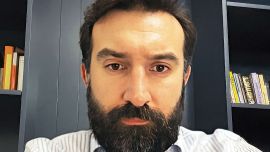Bang in the middle of Argentina, Córdoba was also absolutely central to President Mauricio Macri’s election in 2015. María Eugenia Vidal’s upset win fed the general prejudice that all elections are decided in Buenos Aires province but this is mathematically incorrect. Macri lost the country’s biggest district to his Peronist rival Daniel Scioli, the outgoing Buenos Aires provincial governor, by 4.8 to 4.6 million votes in the run-off, but it was his Córdoba landslide of almost a million (some 930,000 votes, to be more exact) which gave him his final nationwide margin of 679,000 and hence the presidency (note that beyond these two provinces the overall result was an almost even tie).
Macri’s chances of duplicating that feat this year look remote when viewed against the current bleak socio-economic scenario, compounded by the total coalition shambles in the province (see further below) but it should be underlined that t h e lopsided 2015 result owes far less to ‘Macrimania’ than ‘Cristinafobia.’ For one reason or another the home of Argentina’s oldest university has always been intensely averse towards last Thursday’s Book Fair star – even in her 2011 presidential landslide of 54 percent wearing her widow’s weeds she only polled 37 percent here, while in 2007 she scraped a meagre 23 percent, losing the province to current presidential dark horse Roberto Lavagna, who was then running for the Radicals (which would make him very much the man to watch in Córdoba this year, if his presidential candidacy does eventually materialise). Córdoba is thus a proven king-maker (or queenbreaker) yet that is not the reason why it is now jumping a queue based on ascending order of electorate magnitude by seven weeks – the urgency obviously comes from tomorrow’s provincial elections.
These elections (with a single ballot) will be contested by a dozen gubernatorial candidates, with incumbent Peronist Governor Juan Schiaretti the runaway opinion poll leader, thanks largely to the split in Cambiemos – not between the main coalition partners but between two fellow-Radicals, Lower House Cambiemos caucus leader Mario Negri, running under the slightly retweaked label of Córdoba Cambia, and outgoing Córdoba mayor Ramón Mestre for the traditional Radical party (Unión Cívica Radical). While Radicals are split between this pair, Negri enjoys the support of the national government, the other two Cambiemos partners (Macri’s PRO and the Civic Coalition) and the Civic Front led by the wisecracking Luis Juez (a locally important exsenator who was the independent mayor of the provincial capital between 2003 and 2007 and Macri’s ambassador in Quito, until making undiplomatically uncomplimentary remarks about personal hygiene in Ecuador).
Opinion polls are giving Schiaretti 40 to 45 percent, Negri around a quarter of the vote and Mestre about 10 percent – this leaves little more than 20 percent for the other nine candidates (representing four local parties, three leftist splinters, Cristina’s Civic Unity and the Humanists) with 15-20 percent undecided. In the provincial capital (containing around 40 percent of Córdoba’s electorate) Mestre replaces Negri as the runner-up in the mayoral race with 24 percent for his man Rodrigo de Laredo, as against 18 percent for Juez, but Peronist deputy Martín Llaryora leads both with 31 percent, according to recent opinion polls. Cambiemos thus runs a huge risk of losing this Radical stronghold (run by Mestre for the last two terms and by his father the late ex-governor Ramón Mestre Senior before him for two more terms in 1983-91 with always Radicals between the two Mestres) to a Peronist with less than a third of the vote – a gigantic humiliation and quite needless, basically arising from the refusal of two Radical bigwigs to relax an even bigger sense of entitlement.
This time last year Schiaretti’s likely victory tomorrow might have served as a presidential springboard but is now heading nowhere as a result of late Peronist governor José Manuel de la Sota’s road accident death eight months ago. Since Schiaretti seemed as good a prospect as any nonKirchnerite Peronist, the two men had a tacit deal that De la Sota would be willing to return for his fourth gubernatorial term, if the governor fancied a presidential shot. Without De la Sota and with more stents than local Cambiemos has splinters, Schiaretti would probably settle for serving out the upcoming term.
With all the imminence of tomorrow’s provincial election, far less interest in October’s national Congress voting, which does not include the three senators (PRO’s Laura Rodríguez Machado and the Civic Front’s Ernesto Martínez for Cambiemos and Carlos Caserio of the Union for Córdoba responding to Schiaretti) who remain in the Upper House until 2021. As always, half of the 18 deputies vacate their seats this year (see box on facing page).
As a major province, Córdoba has an above-average share of prominent deputies – no less than the two main caucus leaders of the ruling coalition, PRO’s Nicolás Massot and Negri, with the latter the overall Cambiemos whip. Neither is projecting a parliamentary future – Negri is Macri’s gubernatorial candidate tomorrow while a disenchanted Massot (like Lower House Speaker Emilio Monzó, an advocate of a broader, more flexible governing coalition) has, also like Monzó, announced his exit from parliamentary life, although the recent return to fashion of consensus politics might just make him think again.
Other newsworthy names among Cambiemos deputies are Brenda Austin (a leading advocate of last year’s abortion bill within government ranks), Diego Mestre (brother of the outgoing provincial capital mayor) and Héctor Baldassi (the former football referee of 2010 South Africa World Cup fame who pioneered PRO in this province). In opposition ranks, Llaryora is Córdoba mayoral frontrunner amid Cambiemos disarray while Adriana Nazario is De la Sota’s widow.
Landlocked Córdoba is often described as “Mediterranean” in local Spanish due its central location. Even older than Buenos Aires (founded in 1573 by Jerónimo de Cabrera, who was rewarded by being beheaded in Lima the next year for not finding Eldorado), Córdoba would surely seem a more suitable new capital than Raúl Alfonsín’s eccentric 1987 choice of Viedma – indeed it has already been Argentina’s capital twice (during the English invasion of 1806 and Juan Perón’s overthrow in 1955).
Agriculture in the province precedes Cabrera by around 1,000 years with the Comechingones indigenous, who successfully resisted Spanish penetration for 30 years. In colonial times Córdoba functioned as a centre for Jesuit education and the slave trade alike. Initially a royalist stronghold, Córdoba joined the May Revolution in 1814, in time to attend the Congress of Tucumán for the declaration of independence in 1816. Economic take-off quickly followed the landlocked province’s first rail connection to the sea in 1870 with Latin America’s first hydro-electric plant at Dique San Roque in 1880. Heavy industry centred on cars and other machinery grew rapidly, creating a numerous workforce – one result was the ‘Cordobazo’ uprising against a military junta 50 Mays ago in 1969. Another violent episode was the rioting and looting during a police mutiny in 2013 but only one death in each upheaval – in general this is a stable, peaceful and conservative province. The economy is advanced – almost two-thirds of the workforce in services, a quarter in manufacturing and a tenth in agriculture.
Not much space for political history but 59 pre-democratic governors (including the Reynafé brothers who killed Facundo Quiroga in 1835), 23 governors and 43 trustees 1916-83 and only four since then (Radicals Eduardo Angeloz and Ramón Mestre until 1999 and Peronists De la Sota and Schiaretti all this century). The 20th century Radical hegemony was effectively founded by Amadeo Sabattini (1936-40) and took Arturo Illia to the presidency (1963-6).
Argentina’s second most populous province with over 3.5 million people, Córdoba also has its second-largest city (1,329,604 in the 2010 census). Córdoba has its famed 1613 university (leading to its nickname ‘La Docta’) and colonial churches, but it is basically a modern business-minded cit y w ith plent y of shopping. Around half of tourism heads to the Sierras hills containing numerous resorts each with their own charm – Villa Carlos Paz, Cosquín with its music festivals, La Falda, Capilla del Monte, Ascochinga, Mina Clavero, Anglo-Argentine La Cumbre, Teutonic Villa General Belgrano which received the Graf Spee survivors, etc. Alta Gracia with its Jesuit mission and Che Guevara and Manuel de Falla museums is also well worth a visit. Río Cuarto (founded in 1786) is the second city with 163,048 people in the last census while Villa María is also into six digits.
No room for more – now let’s see what tomorrow’s voting brings.
#16 Córdoba
Electorate tomorrow: 2,889,973
Governor: Juan Schiaretti (Peronist)
Senators: Three (2 Cambiemos, 1 Peronist/Union for Córdoba)
Deputies: 18 (10 Cambiemos including 5 Radicals and 4 PRO, 5 Peronist/ Córdoba Federal, 3 Kirchnerites)
On the ballot: Nine of 18 deputies
























Comments